Many of the 18th century oil paintings which come to our team at Fine Art Restoration Company are portraits. In 18th century Britain, portraiture became a profitable business for many artists, who depicted not only private sitters but also famous faces, as the idea of celebrity began to take shape. The commercial dominance of portraits in this era now makes them a frequent guest in our studio and in art markets around the world. However, their old age puts them in a vulnerable position, as do the numerous environments they may have faced in the 300 years since their creation.
 Above: a detail from ‘Lady Elizabeth Delmé and Her Children’ by Sir Joshua Reynolds, 1777-79
Above: a detail from ‘Lady Elizabeth Delmé and Her Children’ by Sir Joshua Reynolds, 1777-79
Our specialist easel painting conservators have a great deal of knowledge when it comes to 18th century art. This is due to their everyday experience in the restoration studio, as well as their academic training. In this article we will discuss the themes behind some of the portraits our team have restored, as well as the risks faced by 18th century portraiture.
Looking at 18th century portraits
The hierarchy of fine art often focuses on the merit of genre. Following the renaissance and the artistic period which followed, the most renowned pieces were that of ‘history painting’ with vast creative depth in their depiction of historical, mythological or biblical scenes. The genre of portraiture was sometimes compared with still life, as it copied a literal subject matter onto canvas. However, there was a great deal of profit to be made from portrait painting as wealthy merchants and a growing middle class grew more dominant in society. In Great Britain, artists were seldom able to compete with the grand history paintings produced by their European rivals, and so developed a grand form of portraiture with the creativity and allegory of this higher genre.
 Above: an example of a European history painting – detail from ‘Diana and Cupid’ by Pompeo Batoni, 1761
Above: an example of a European history painting – detail from ‘Diana and Cupid’ by Pompeo Batoni, 1761
Whilst the portraits of former centuries presented a rather austere and straightforward depiction of the sitter, from the late 17th century onwards a more embellished style began to emerge. The styling of pastoral landscapes, as well as a direct reference to classical robes and drapery, hinted towards an ancient power and idyll. This theming grew in complexity, adding particular items and aspects which exaggerated the personality of the sitter. For example, an animal may be introduced to secure certain themes; a dog may represent loyalty, a lamb may show purity, a peacock is a classical symbol of immortality, and a parrot is often depicted with the Virgin Mary and therefore compels ideas of religious devotion or maternity.
 Above: female portraits from the 16th century, 17th century and 18th century
Above: female portraits from the 16th century, 17th century and 18th century
Godfrey Kneller came to England from what is present-day Germany in the latter half of the 17th century. He took up this enterprising focus on portrait painting, producing artwork with a formula for success. Many of his portraits include luscious classical drapery and fashionable grand wigs, but this was added later in the studio as his commercial process involved taking just a facial sketch of the sitter and adding all of the embellishment creatively, not from real life. Kneller went on to become a court painter or ‘Principal Painter in Ordinary’ to the King and heavily influenced the way in which portraits would go on to be produced.
 Above: a selection of Godfrey Kneller portraits from the early 18th century
Above: a selection of Godfrey Kneller portraits from the early 18th century
By the end of the 18th century, artists were experts in depicting their sitters with impactful connotations to classical stories and ideas of morality and beauty. Many portraits may appear as true ‘history paintings’ due to their indulgence in dressing up the sitter as a particular character or allegorical figure. Aristocratic and upper class women may have been dressed in robes and given the likeness of ancient goddesses, compelling their virtues through this association. Classical tales were also reenacted, allowing the portrait to stand out as more than a simple depiction, but as a moral and academic piece of work.
 Above: a detail from a Gainborough portrait with an example of a painterly landscape which featured prominently in his work
Above: a detail from a Gainborough portrait with an example of a painterly landscape which featured prominently in his work
Many artists, once well established, would have a team working on each painting. It is a misconception that all artists completed their finished pieces alone, as there were often several students or specialists in different areas. For instance, a skilled drapery painter would complete the aspects of clothing and surrounding textiles, whilst a landscape artist worked on the background. The named artist was responsible for the overall ideas of the composition, as well as the faces and sometimes the hands of the sitter. However, there are famous examples of named artists who completed the majority of the work alone, such as Thomas Gainsborough who had a passion for landscape painting and so included all of this by his own hand.
 Above: a detail from ‘Three Ladies Adorning A Term Of Hymen’ by Joshua Reynolds, 1773 – this portrait uses classical mythology and symbolism to enhance the virtues of three sisters as they decorate the Greek god of marriage and fertility
Above: a detail from ‘Three Ladies Adorning A Term Of Hymen’ by Joshua Reynolds, 1773 – this portrait uses classical mythology and symbolism to enhance the virtues of three sisters as they decorate the Greek god of marriage and fertility
This grand style of portraiture was partially developed by Joshua Reynolds, who went on to be the first president of the Royal Academy. His inspiration came from his grand tour of Europe, where many renaissance pieces and classical artworks would have been studied. Reynolds, who also went on to serve Royalty, took the formula developed by Kneller and allowed it to align itself with the higher forms of art he had witnessed in Europe. It was also a public-facing decision, as the Royal Academy would famously hold summer exhibitions of such work. The introduction of the printing press and commercial engravings also created a market for paper copies to be sold, therefore portraits of grand ladies dressed as characters could be sold as historic scenes or for their celebrity status, rather than simple depictions of aristocrats.
 Above: a detail from ‘The Archers’ by Joshua Reynolds, 1769 – this portrait expands upon the chivalry of the sitters by using a setting of an ancient forest and an athletic posture reminiscent of classical tales
Above: a detail from ‘The Archers’ by Joshua Reynolds, 1769 – this portrait expands upon the chivalry of the sitters by using a setting of an ancient forest and an athletic posture reminiscent of classical tales
Famous portrait artists of 18th century Britain
- Godfrey Kneller (1646-1723)
- Joshua Reynolds (1723-1792)
- Thomas Gainsborough (1727-1788)
- Thomas Lawrence (1769-1830)
- William Hogarth (1697-1764)
- Joseph Wright of Derby (1734-1797)
- George Romney (1734-1802)
- Thomas Hudson (1701-1779)
- Jonathan Richardson (1667-1745)
- Angelica Kauffman (1741-1807)
- Francis Hayman (1708-1776)
- Nathaniel Dance-Holland (1735-1811)
- Francis Cotes (1726-1770)
- Allan Ramsay (1713-1784)
- Edward Penny (1714-1791)
 Above: 18th century British portraits from artists George Romney, John Hoppner, William Beechey, Henry Raeburn, and Francis Cotes
Above: 18th century British portraits from artists George Romney, John Hoppner, William Beechey, Henry Raeburn, and Francis Cotes
Which risks face 18th century portraits?
Typical damages facing 18th century art will most likely be connected to their age. Their materials may start to fail over time, including the discolouration of historic varnish. The lining of the canvas may also start to come away as the structure breaks down and the wooden stretcher bars and their metal joins may decay over time due to the atmosphere, rust, pests or natural deterioration.
 Above: a late 18th century portrait before and after a varnish removal by our conservator, removing hundreds of years of ingrained dirt and contamination
Above: a late 18th century portrait before and after a varnish removal by our conservator, removing hundreds of years of ingrained dirt and contamination
18th century portraits may be more than 300 years old, in that time they may have been kept in less than ideal conditions and faced environments filled with smoke and debris. Historically, homes were filled with a lot more dust and airborne particles than today. This era of painting may have also been given a thick layer of varnish which never quite sets, leaving a sticky surface which easily attracts dirt. Some particles may be toxic and pose a danger to the paint layer, this is especially true of those which have come from fireplace smoke or nicotine. If a painting has a clouded layer this may be moisture trapped under the surface due to damp or humid conditions in the past or presently.
 Above: an 18th century portrait with deterioration to the paint layer including deep and unstable cracks – before restoration by our team (right) and after (far left)
Above: an 18th century portrait with deterioration to the paint layer including deep and unstable cracks – before restoration by our team (right) and after (far left)
Although it is common to see a fine pattern of cracks on a painting, known as craquelure, this may worsen and lead to visual disturbance or loss as the paint begins to lift away and flake. This can be compelled by an unstable environment, or happen naturally due to the way in which the painting was originally created, such as lack of preparation on the canvas or unusual and easily disturbed pigments.
 Above: an 18th century portrait with mould and moisture damage – before restoration (left) mid-way through varnish removal (centre) and following varnish removal (right)
Above: an 18th century portrait with mould and moisture damage – before restoration (left) mid-way through varnish removal (centre) and following varnish removal (right)
It should be kept in mind that a painting may have been involved in a disaster, such as a flood or fire, at some point in their long life. Historic repairs may have been carried out due to this or accidental damage (such as tears, stains, or scratches to the canvas) and may not have been performed as sympathetically as contemporary techniques would ensure. Some parts may have been overpainted or entirely altered in later centuries. Historic restoration may fail over time, requiring intervention from a present day conservator who can replace this with long-lasting and scientifically precise methods which offer greater protection.
 Above: an 18th century portrait with a large tear before restoration by our conservators (left) and after thread-by-thread restoration by our team (right)
Above: an 18th century portrait with a large tear before restoration by our conservators (left) and after thread-by-thread restoration by our team (right)
Restoring a Godfrey Kneller portrait
In 2021, our London studio restored a large portrait which was attributed to Godfrey Kneller. The piece depicts an aristocratic woman named Dorothy Smith, she sits in flowing drapery within a sunset landscape. Situated in a typical style which is half sheltered, half open air, this is a fairly dark portrait even after restoration has been completed. This may suggest a sombre or reflective mood.
Above: our conservator testing the painting to see which type of treatment it may require and what the results may be
On the left, a devoted lamb looks up at Dorothy, on the right she leans upon a hat which is often worn with a costume of a shepherdess. This alludes to a pastoral lifestyle and one with purity. This is compelled further with the inclusion of immaculate pearls along her neckline. The flower she holds gently in her fingers is likely a poinsettia, the red tones are not only passionate, but typically this flower is a symbol connected to the blood of Christ. These elements enhance her values as a moral and pious wife who is devotely Christian. From research we know that she was married to Charles Withers of Hall Place, now known as Oakley Hall. The themes of the piece are typical of the early 18th century, which led the way for the illustrious style later developed by Reynolds and his contemporaries.
 Above: areas of damage on the portrait from left to right – yellowing varnish (part way through removal), several tears and abrasions, historic rusting nails found in the stretcher bars, evidence of vermin and a scratch
Above: areas of damage on the portrait from left to right – yellowing varnish (part way through removal), several tears and abrasions, historic rusting nails found in the stretcher bars, evidence of vermin and a scratch
When the portrait arrived in our studio it was discoloured and the canvas had been torn in three places. The surface was also dented and uneven, putting the paint layer at risk of becoming unstable. Our easel painting conservator, who is well-versed in this era and style of artwork, tested several patches to work out how safely it could be cleaned and what the final result may show. She cleaned the surface gently, before removing the varnish layer to reveal the original colours of the artwork. Dorothy’s skin was a striking difference, as the once yellow tinted tone gave way to a glowing, snow white complexion. The golden drapery was also enhanced, allowing the silk and satin textures to shine. The red poinsettia clearly matched the bright ruby on the shoulder of her dress, and the lamb in the corner of the piece was now less shrouded in shadow.
 Above: after varnish removal any areas of uneven texture or deep cracks are smoothed out and consolidated with a filler (as seen here) before being carefully colour-matched with conservation grade pigments
Above: after varnish removal any areas of uneven texture or deep cracks are smoothed out and consolidated with a filler (as seen here) before being carefully colour-matched with conservation grade pigments
Consolidation was completed on areas of the portrait which were at risk of loss, readhering the paint layer to the canvas to ensure they did not fall away. This was particularly relevant around the areas which had been torn, as consolidation was completed alongside a thread by thread tear repair which precisely bonded the broken canvas fibres back together.
Finally, our conservator coated the painting with a new varnish. This is non-yellowing and UV reducing, offering greater protection than the traditional variety. She then retouched areas of missing paint with exact shades to colour match the original composition. This was completed with a small brush over a course of many hours, as our team does not alter anything other than the precise areas which require attention, sometimes this can be as small as a pinhead. Retouching all missing pigments ensures that the underlying canvas is not exposed and the overall paint layer is completely stable. This is completed on top of the varnish layer so as not to disturb the original paint, this also means it will never be confused with the original and can be easily removed by a future conservator if required.
 Above: the portrait before and after a full restoration by our easel painting conservator
Above: the portrait before and after a full restoration by our easel painting conservator
The completed restoration ensured that the portrait was in full health and ready to go back on display without any fear of continued deterioration. After 300 years, the painting now appears in the same condition as the day it was created, giving it back historic and artistic integrity.
Contact our team for further information
If you have a painting from this era which you have concerns about, or if you would like guidance on how to best care for such an artwork, please contact our team for helpful advice.
You can speak to us via email [email protected] or telephone 0207 112 7576

 Above: a detail from ‘Lady Elizabeth Delmé and Her Children’ by Sir Joshua Reynolds, 1777-79
Above: a detail from ‘Lady Elizabeth Delmé and Her Children’ by Sir Joshua Reynolds, 1777-79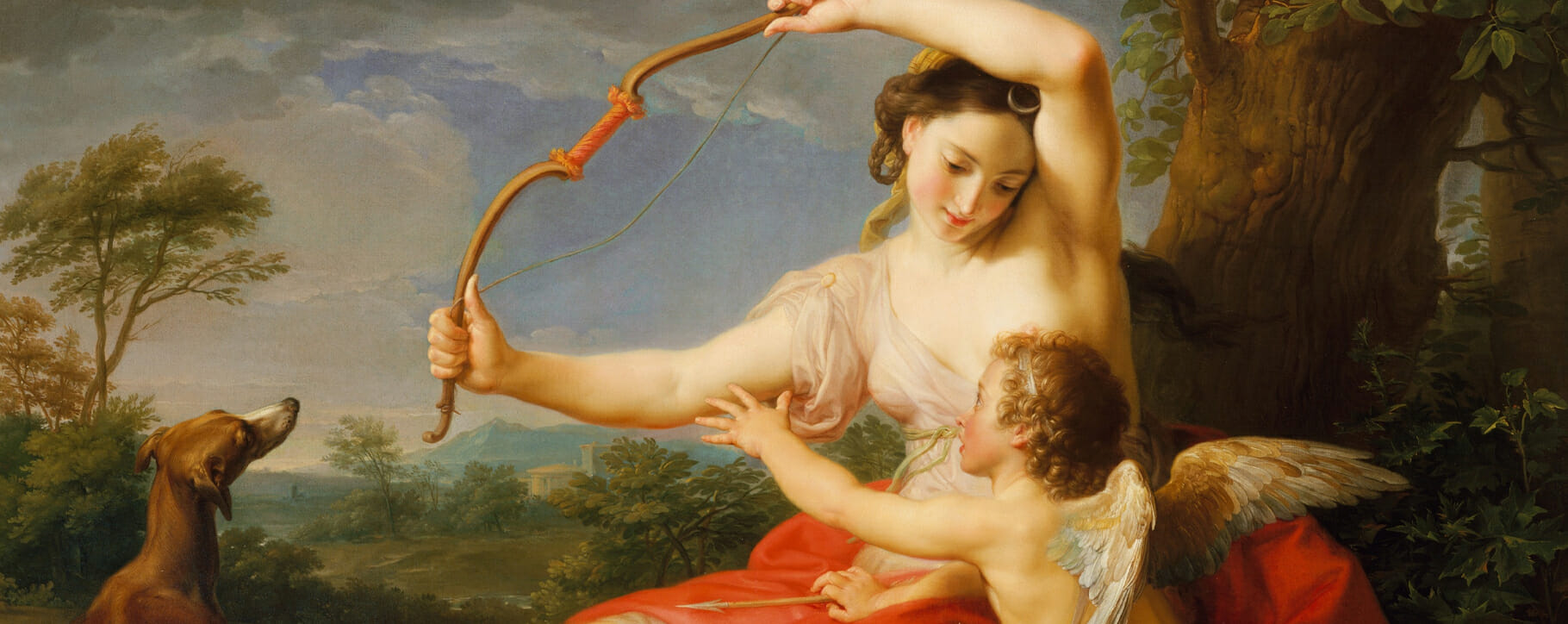 Above: an example of a European history painting – detail from ‘Diana and Cupid’ by Pompeo Batoni, 1761
Above: an example of a European history painting – detail from ‘Diana and Cupid’ by Pompeo Batoni, 1761 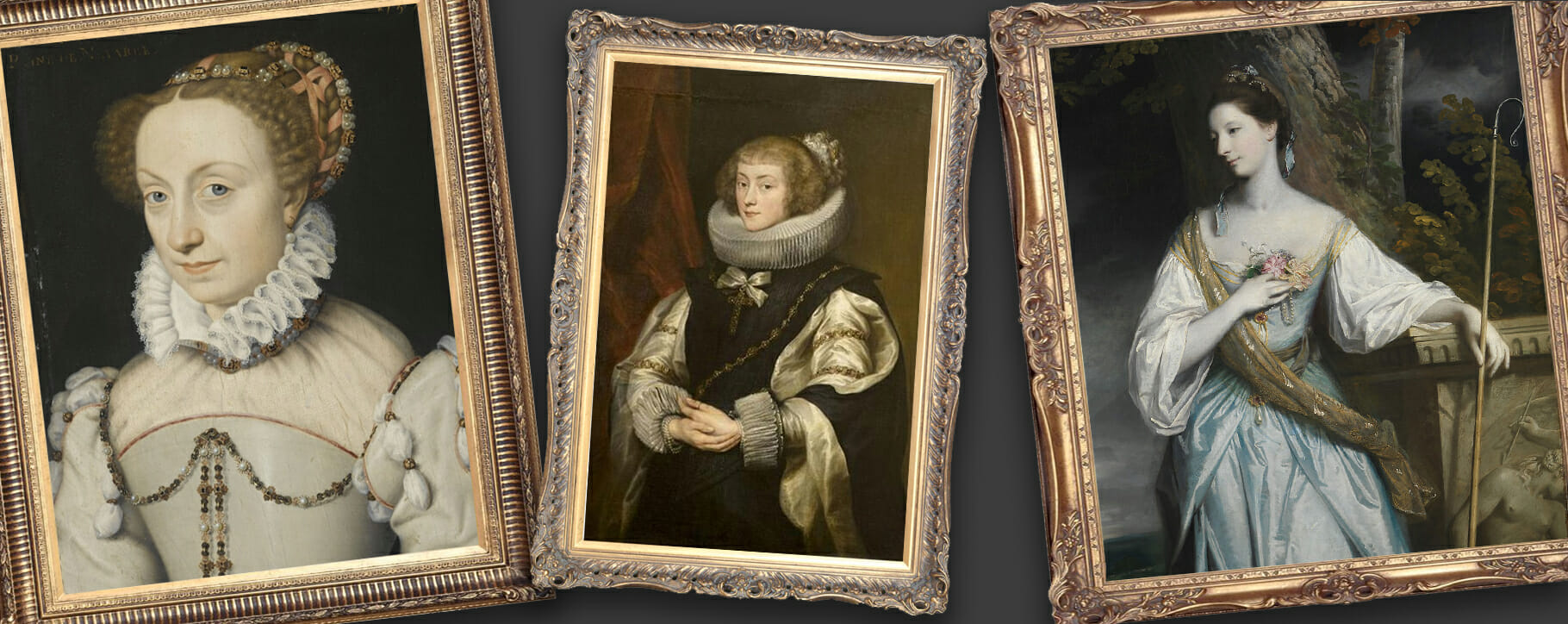 Above: female portraits from the 16th century, 17th century and 18th century
Above: female portraits from the 16th century, 17th century and 18th century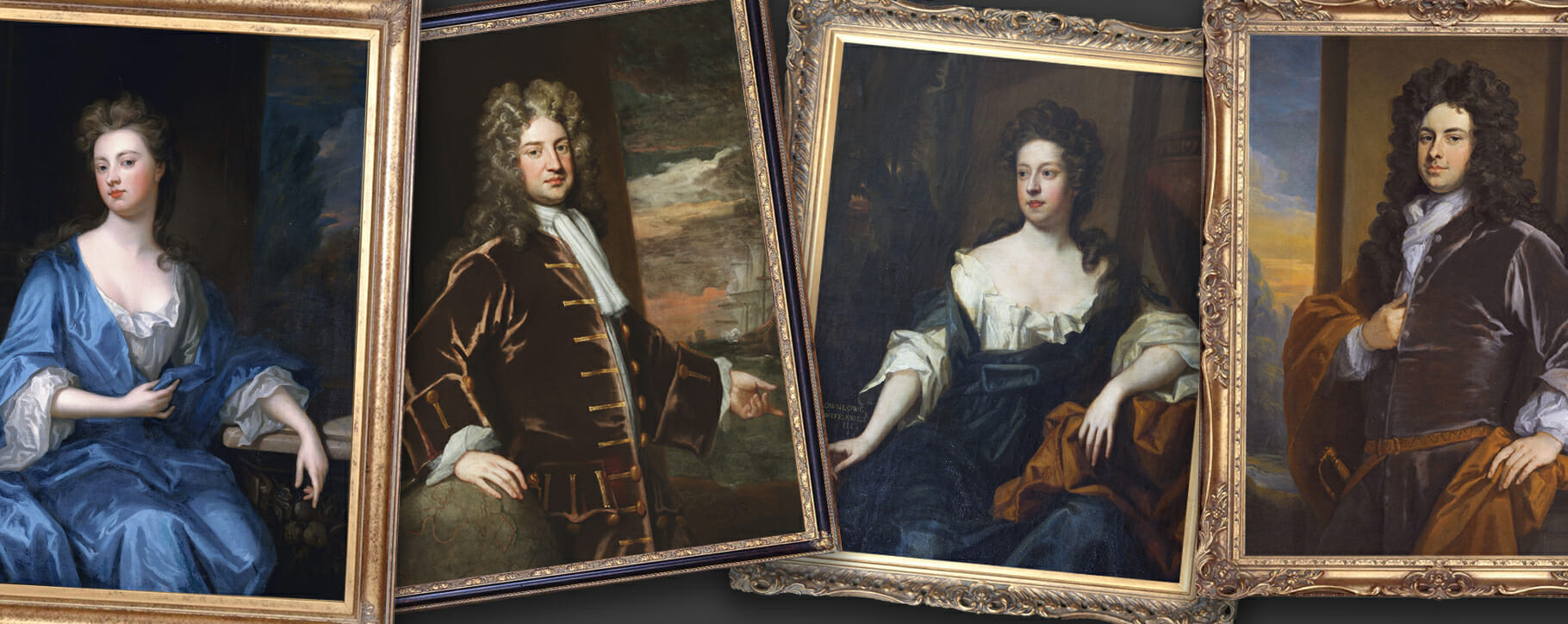 Above: a selection of Godfrey Kneller portraits from the early 18th century
Above: a selection of Godfrey Kneller portraits from the early 18th century Above: a detail from a Gainborough portrait with an example of a painterly landscape which featured prominently in his work
Above: a detail from a Gainborough portrait with an example of a painterly landscape which featured prominently in his work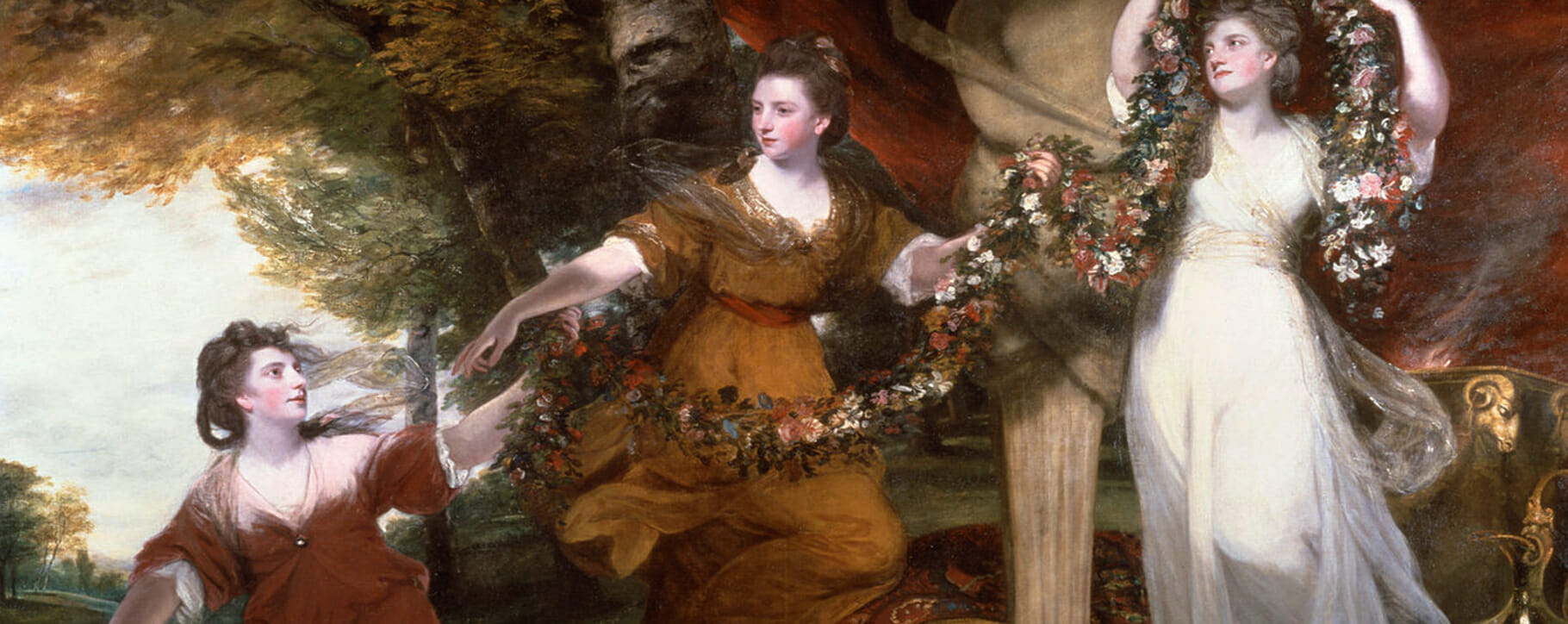 Above: a detail from ‘Three Ladies Adorning A Term Of Hymen’ by Joshua Reynolds, 1773 – this portrait uses classical mythology and symbolism to enhance the virtues of three sisters as they decorate the Greek god of marriage and fertility
Above: a detail from ‘Three Ladies Adorning A Term Of Hymen’ by Joshua Reynolds, 1773 – this portrait uses classical mythology and symbolism to enhance the virtues of three sisters as they decorate the Greek god of marriage and fertility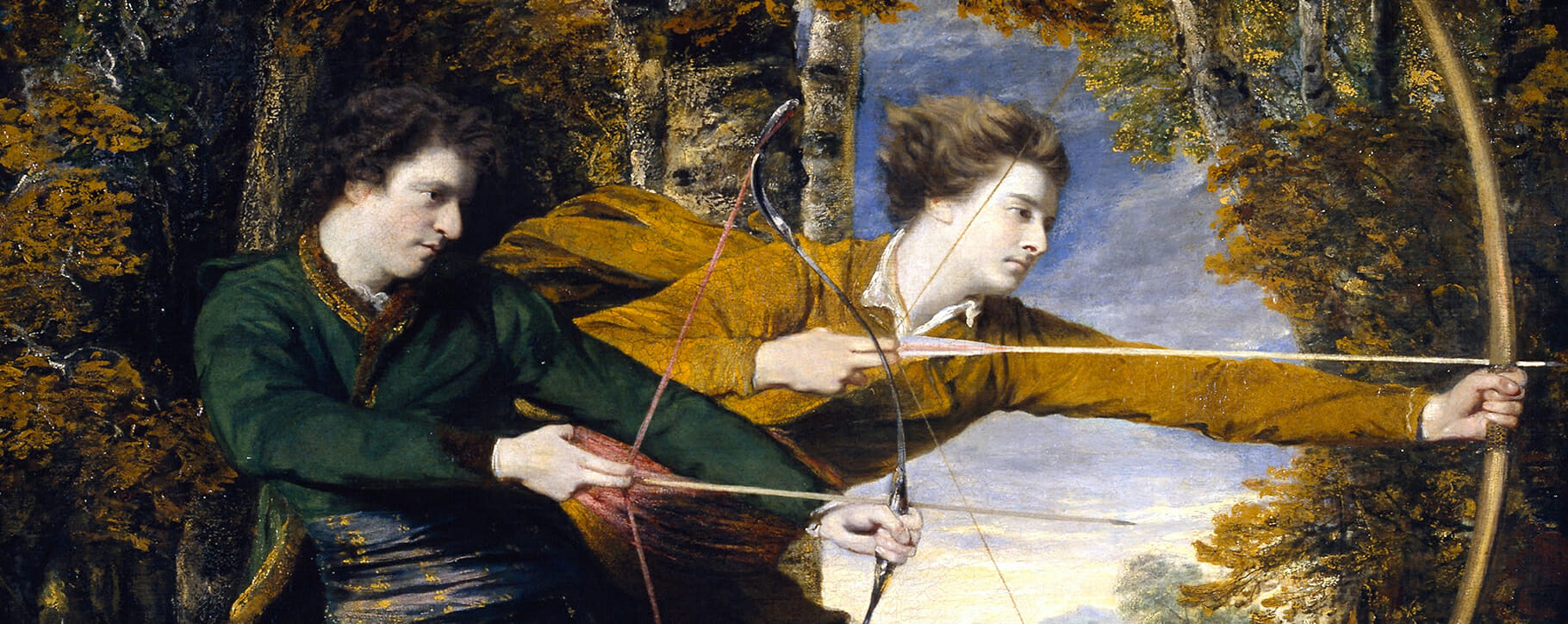 Above: a detail from ‘The Archers’ by Joshua Reynolds, 1769 – this portrait expands upon the chivalry of the sitters by using a setting of an ancient forest and an athletic posture reminiscent of classical tales
Above: a detail from ‘The Archers’ by Joshua Reynolds, 1769 – this portrait expands upon the chivalry of the sitters by using a setting of an ancient forest and an athletic posture reminiscent of classical tales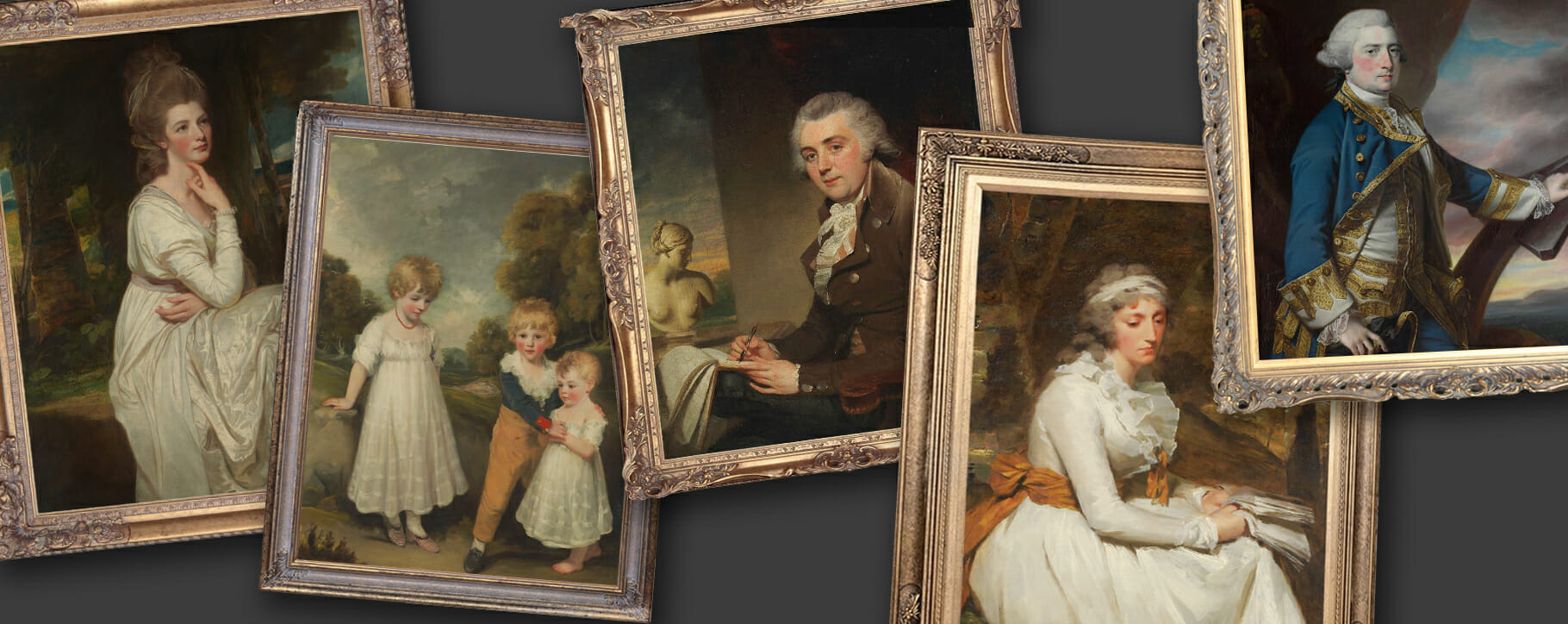 Above: 18th century British portraits from artists George Romney, John Hoppner, William Beechey, Henry Raeburn, and Francis Cotes
Above: 18th century British portraits from artists George Romney, John Hoppner, William Beechey, Henry Raeburn, and Francis Cotes Above: a late 18th century portrait before and after a varnish removal by our conservator, removing hundreds of years of ingrained dirt and contamination
Above: a late 18th century portrait before and after a varnish removal by our conservator, removing hundreds of years of ingrained dirt and contamination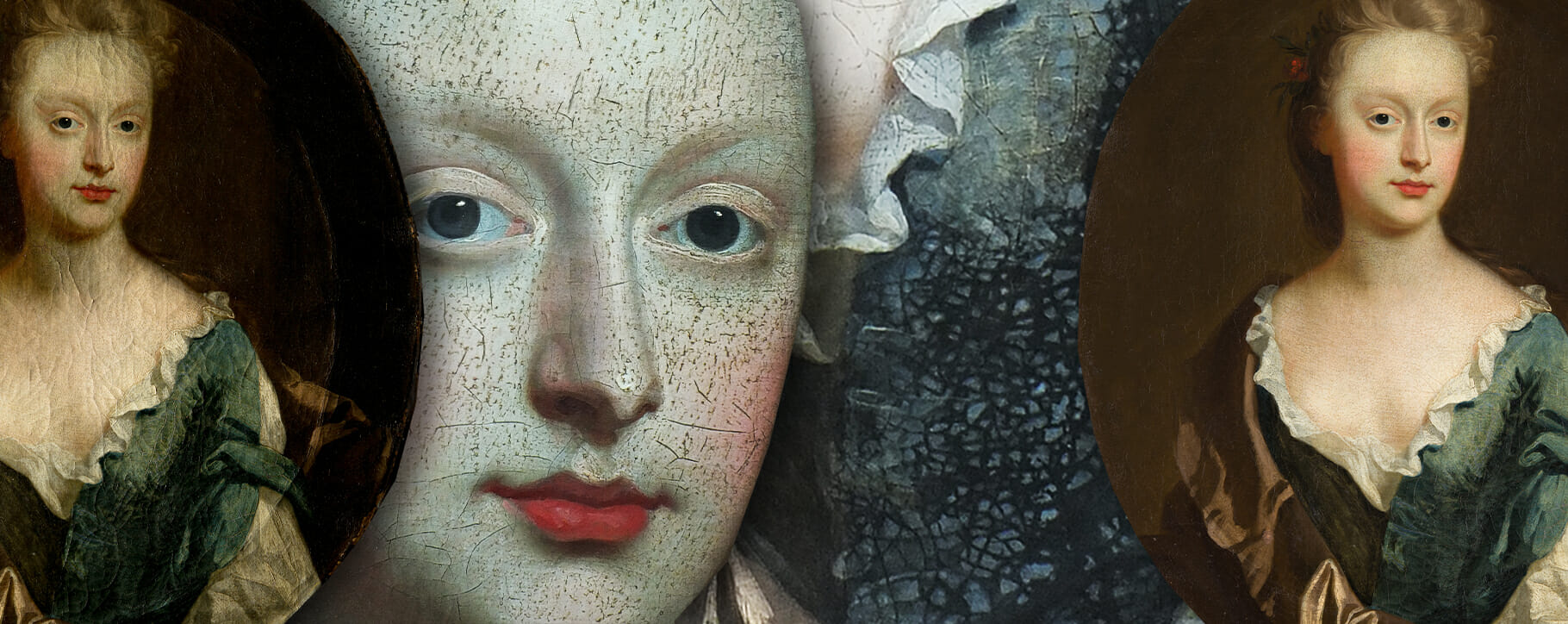 Above: an 18th century portrait with deterioration to the paint layer including deep and unstable cracks – before restoration by our team (right) and after (far left)
Above: an 18th century portrait with deterioration to the paint layer including deep and unstable cracks – before restoration by our team (right) and after (far left)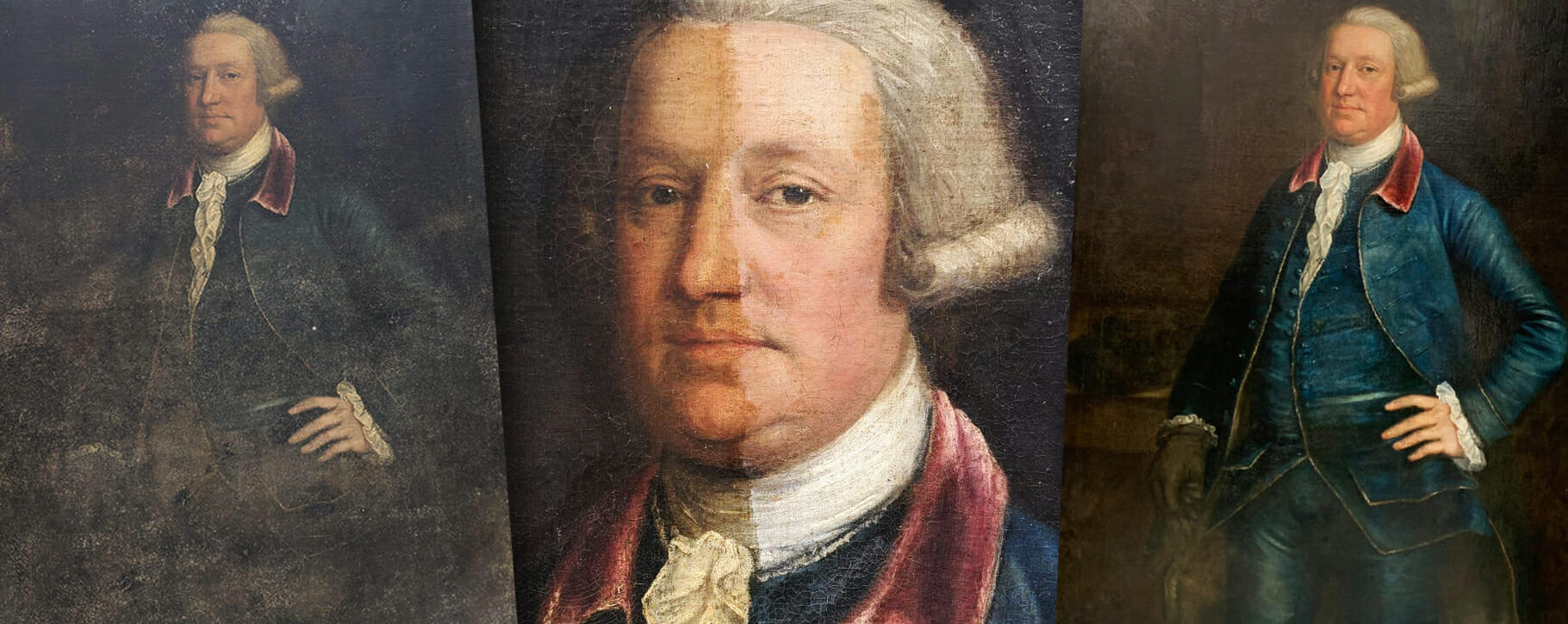 Above: an 18th century portrait with mould and moisture damage – before restoration (left) mid-way through varnish removal (centre) and following varnish removal (right)
Above: an 18th century portrait with mould and moisture damage – before restoration (left) mid-way through varnish removal (centre) and following varnish removal (right)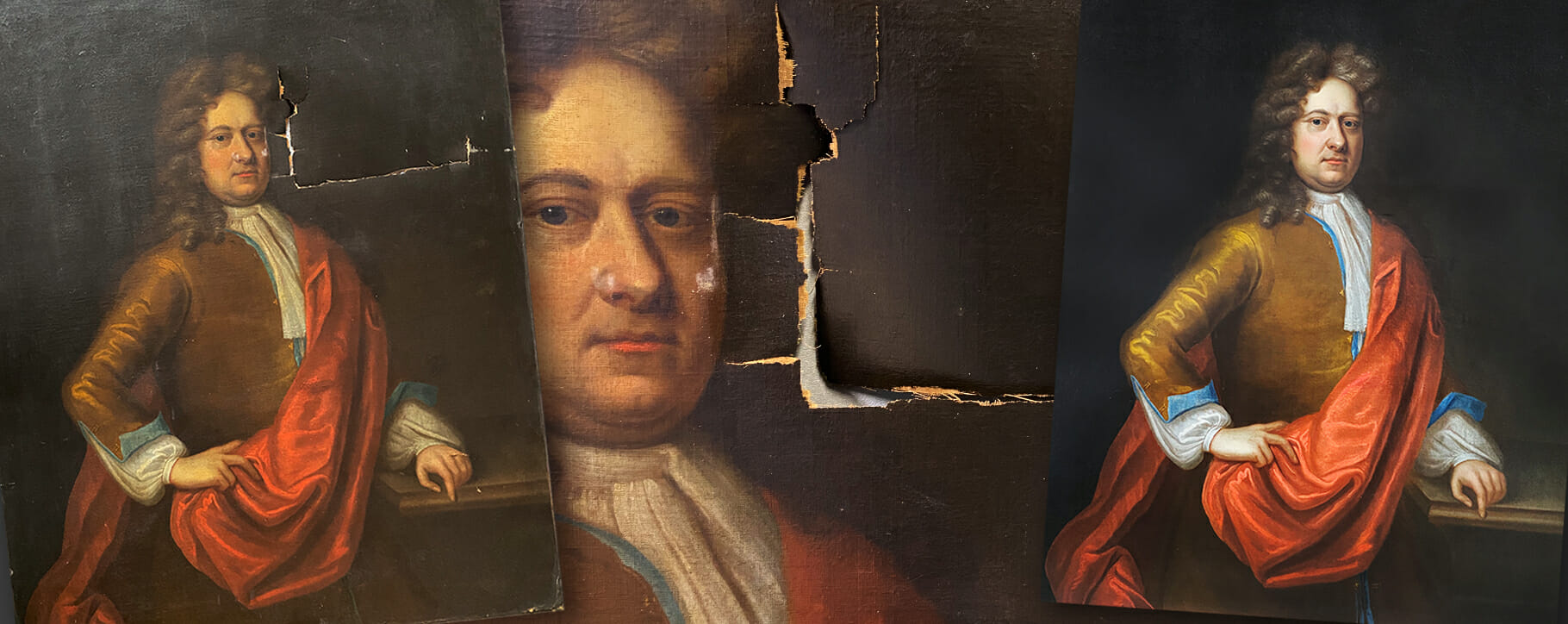 Above: an 18th century portrait with a large tear before restoration by our conservators (left) and after thread-by-thread restoration by our team (right)
Above: an 18th century portrait with a large tear before restoration by our conservators (left) and after thread-by-thread restoration by our team (right) Above: areas of damage on the portrait from left to right – yellowing varnish (part way through removal), several tears and abrasions, historic rusting nails found in the stretcher bars, evidence of vermin and a scratch
Above: areas of damage on the portrait from left to right – yellowing varnish (part way through removal), several tears and abrasions, historic rusting nails found in the stretcher bars, evidence of vermin and a scratch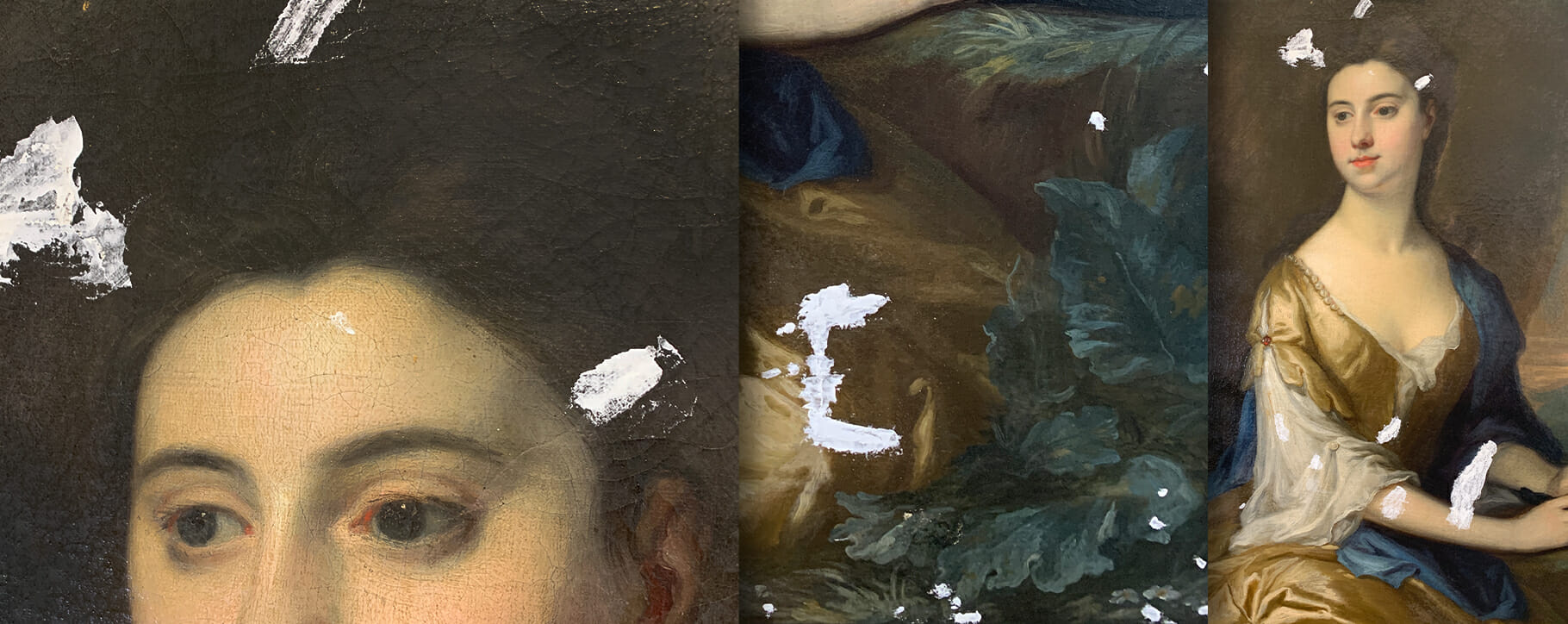 Above: after varnish removal any areas of uneven texture or deep cracks are smoothed out and consolidated with a filler (as seen here) before being carefully colour-matched with conservation grade pigments
Above: after varnish removal any areas of uneven texture or deep cracks are smoothed out and consolidated with a filler (as seen here) before being carefully colour-matched with conservation grade pigments Above: the portrait before and after a full restoration by our easel painting conservator
Above: the portrait before and after a full restoration by our easel painting conservator




